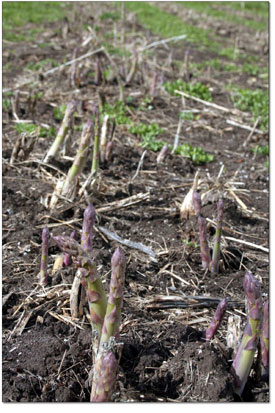| ||
The asparagus exception
by Chef Boy Ari According to Miss Manners, asparagus is one of the few foods acceptable to eat with one’s hands. The “asparagus exception” originated from a time when people ate using real silverware, which got stained by asparagus enzymes. But even with this exception, asparagus can still be tricky in polite company. Suppose those you’re dining with don’t know about . Should you risk offending them? Do you cut the spears to pieces with your knife and fork, even though it’s not necessary? Ancient Roman bon vivant Marcus Apicus, the author of the oldest known surviving cookbook in the world, De Re Culinaria, has his own way around this issue of decorum. He suggests pounding asparagus with pepper, lovage, coriander, savory, onion, wine, olive oil, eggs and a fermented fish sauce called garum. This paste is then baked, and probably not eaten with fingers. (I bet it’s good on chips or crackers, though.) My fingers were itching as I stood in the biggest asparagus patch I’ve ever seen, at the front-end of asparagus season. At first it looked like an empty brown field with scattered straw and patches of clover. But as soon as you see your first shoot, your eyes focus and you see the group – it’s kind of like mushroom hunting. They even look like morels, each with its own tilt and gnomish shape. Most of the shoots were surprisingly wide of girth. “They’re a bit stogie early on in the season,” says local farmer Steve Dagger, using a noun as an adjective in a way Miss Manners probably wouldn’t have. No, the asparagus patch is no place for the likes of Miss Manners. “Back when we had the CSA going,” recalls Jane Kile, Steve’s partner in asparagus, “the clients would come help on the farm. Mostly women came, and some of the men were complaining that there was ‘too much of a female vibe around here.’ So we planted a field of male asparagus to change that.” That was 11 years ago. Her CSA (Community Supported Agriculture) farm supplied food to her neighbors on a weekly basis throughout the growing season. In addition to pacifying the menfolk, a crop of asparagus is a morale-boosting way to keep everyone happy during the early, lean months of spring. She planted an all-male hybrid variety of asparagus, which yield more than females. “It will grow 6 inches in a day if it’s warm enough,” she says, adding “Today it probably only grew like a tenth of an inch,” in reference to the springtime chill that started the night before and lingered all day. “There’s a formula for calculating how fast it will grow, as a relationship to average daily temperatures,” said Steve. “Some agriculture scientists figured it out to help growers plan their harvests. Something about a coefficient, and a constant gets subtracted…” Asparagus patches will produce for about 18 years before they start to peter out. You have to wait three years after planting before the first harvest. After a five-week harvest, you have to stop and let the shoots grow into plants, which supply the roots with enough energy to make it through the winter. “They grow up into fern-like trees that hang out all summer,” says Jane. “It’s cool under them, the dogs love it.” I asked them each their favorite way of eating asparagus. Jane enjoys a cooked asparagus salad with a sauce of: 2 T tamari (or soy), 1½ t sugar, 1 T dark sesame oil, 1 T white vinegar, 1 T rice wine or dry sherry, ½ t grated fresh ginger. (If you want you can add 1/2 t chili paste.) Cut off the tough, woody bottoms and boil a pound of asparagus spears for two minutes (‘til tender but crisp). Then immediately plunge the spears into ice-cold water. Drain, toss in the dressing and marinate for half an hour before serving, garnished with sesame seeds. Steve, meanwhile, prefers his asparagus in soup, though, he concedes, “it’s kind of pedestrian.” Here’s my rendition of asparagus soup: Peel a head of garlic and oven-roast the cloves at 350 degrees until completely soft. Meanwhile, cut the woody bases off of 1½ pounds of fresh asparagus, break off the tips, and cut the remaining stalks into 1-inch pieces. Heat 4 tablespoons butter in a pan, sauté two medium leeks, chopped, until tender. Add the asparagus stalks, garlic and enough chicken stock to cover them. Cook until stalks are tender. In another pan, boil the tips for five minutes. Puree the asparagus/garlic mixture, return to the pan, add 3 more cups of stock, bring to a simmer, then remove from heat. Season with salt and pepper, add the boiled tips, and stir in 3 tablespoons of lemon juice, and two raw cloves of garlic, minced. There was nothing pedestrian about this soup. In fact, I bet Miss Manners would slurp it down so fast it would run down her chin. •
|
In this week's issue...
- May 15, 2025
- End of the trail
Despite tariff pause, Colorado bike company can’t hang on through supply chain chaos
- May 8, 2025
- Shared pain
Dismal trend highlights need to cut usage in Upper Basin, too
- April 24, 2025
- A tale of two bills
Nuclear gets all the hype, but optimizing infrastructure will have bigger impact


